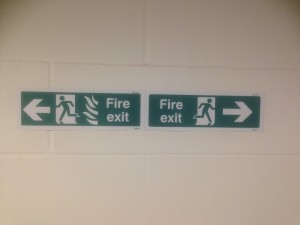
17
Sep
2013

How clear are your emergency signs and could they save a life? Thanks to new standard now adopted throughout the European Union, you can be sure your message is getting across to the people who need to know it in a crisis.
ISO 7010, as the standard is officially known, is the accepted graphic language to relay important safety messages, such as where lifesaving equipment is kept, or the direction of emergency exits.
Since the language was universally adopted, building managers, property owners and estate managers are required to identify hazards and mark the position of emergency equipment and life-saving appliances. Safety managers have an obligation to inform and educate all occupants about risk control, to prohibit certain behaviour and give mandatory instruction, to ensure everyone is kept safe.
But, despite the adoption of the sign language, its universal use is still a fair way off. Look around any public building and you'll see a wide range of graphic symbols, many of which are difficult, even impossible, to understand, or which give conflicting advice. In order to ensure the safety message is crystal clear for all, it is essential businesses and organisations comply with ISO 7010 - and we can help.
All workplaces, including merchant and passenger vessels will now be required to implement and display the new graphical symbols for safety communication. So are you safety compliant?
The road to universally accepted safety signs has been a long one. The International Standard Technical Committee, which is responsible for the implementation of graphical symbols, has worked for more than 20 years to develop the clearest pictures to instantly convey critical information.
International regulations require employers to identify hazards and safety equipment, including fire extinguishers, alarms and escape routes. They must also ensure that the correct equipment and exits are properly installed and labelled using the new instantly recognisable sign language and that employees are made aware of them during training or instruction courses.
Escape routes must follow the shortest route to an exit from any point in the building and health and safety officers must ensure that signs are correctly installed and do not give conflicting messages. And not only must the sign follow agreed format, it must be big enough to be read from a maximum distance. These are set out in BS5499-4.
Fire Security Services are a preferred supplier of Jalite signs - the world leaders in emergency signage. All our engineers are trained by Jalite in "wayfinding" - ensuring the correct signs are placed in the correct place along escape routes and the price of our photo-luminescent sign, including supply and fit in the correct place, is often much less than buying the equivalent sign elsewhere.
So, to ensure you are fully safety compliant, contact Fire Security Services on 01304 842317 or email training@fire-sec.co.uk
© Fire Security 2003-2026 - All Rights Reserved
| Company Number: 04677107 Registered In England & Wales
| Privacy Policy
| Cookie Policy
| Terms & Conditions
| Website by 